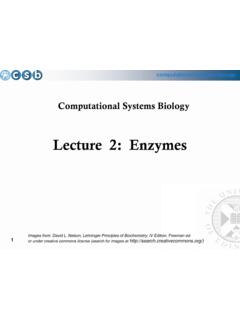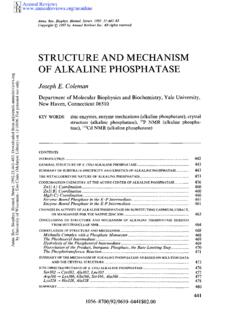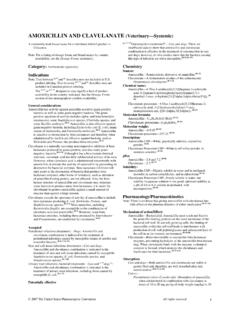Transcription of DRUG NAME: Carboplatin
1 Carboplatin DRUG NAME: Carboplatin SYNONYM(S): CBDCA, JM8, NSC 241240 COMMON TRADE NAME(S): PARAPLATIN , PARAPLATIN-AQ CLASSIFICATION: Alkylating agent Special pediatric considerations are noted when applicable, otherwise adult provisions apply. MECHANISM OF ACTION: Carboplatin is an analog of cisplatin. Like cisplatin, it contains a platinum atom surrounded in a plane by two ammonia groups and two other ligands in the cis position. The other two ligands in Carboplatin are present in a ring structure rather than as two chloride atoms in cisplatin. This difference makes Carboplatin more stable and has less nephrotoxicity, neurotoxicity, ototoxicity and ,2 The exact mechanism of action of Carboplatin is not known.
2 Carboplatin undergoes intracellular activation to form reactive platinum complexes which are believed to inhibit DNA synthesis by forming interstrand and intrastrand cross-linking of DNA molecules. Carboplatin is a radiation-sensitizing ,4 It is cell cycle-phase PHARMACOKINETICS: Interpatient variability 2- to 3-fold variability in AUC with BSA-based ,6 Variability can be reduced with Calvert AUC-based dosing ,7 Oral Absorption poorly absorbed; oral route not used clinically8 Intraperitoneal Absorption peak plasma level within 2-4 h after intraperitoneal instillation with 65% of dose absorbed over 4 h of dwelling2,9 widely distributed, mostly in kidney, liver, skin, tumour tissue; also in erythrocytes cross blood brain barrier?
3 Yes volume of distribution10 ultrafilterable platinum : 17 2 m2 Distribution plasma protein binding Carboplatin : minimal2,11 platinum: 87%,2,12 undergoes intracellular hydrolysis to form reactive platinum complexes active metabolite(s) platinum complexes Metabolism inactive metabolite(s) no information found renal excretion via glomerular filtration; extensively removed by hemodialysis. urine 71% within 24 h terminal half life days (total platinum*)1,10 platinum elimination from erythrocytes.
4 12 days Excretion clearance L/ m2 (total platinum*)10 Gender no information found Elderly clearance may be reduced due to age-related renal function impairment2,11 Children similar to adults6,13 Ethnicity no information found Adapted from reference2 unless specified otherwise. Ultrafilterable platinum consists of Carboplatin and free Carboplatin metabolites; total platinum consists of protein bound and free platinum.
5 Pharmacokinetics of ultrafilterable platinum is clinically more useful as only free platinum species are BC Cancer Agency Cancer Drug Manual Page 1 of 9 Carboplatin Developed: September 1994 Revised: March 2006 Limited revision: May 2007, 1 June 2011, 1 January 2014 Carboplatin USES: Primary uses: Other uses: Brain tumours11 Bladder cancer11 Endometrial cancer11 Breast cancer2 Germ cell tumours11 Cervical cancer2 Head and neck cancer2,11 Ewing s sarcoma5 Ovarian cancer1,11 Leukemia, acute lymphocytic5 Lung cancer, non-small cell2,11 Lung cancer.
6 Small cell2,11 Lymphoma, non-Hodgkin s14 Melanoma11 Neuroblastoma2,5 Osteosarcoma5,15 Rhabdomyosarcoma5 Retinoblastoma2,5 Testicular cancer2.
7 11 Wilms tumour2 *Health Canada Therapeutic Products Programme approved indication SPECIAL PRECAUTIONS: Contraindication: Manufacturer states that Carboplatin is contraindicated in patients with known hypersensitivity to Carboplatin , other platinum agents (eg, cisplatin) or However, with appropriate precautions, rechallenging with Carboplatin or switching to cisplatin has been tolerated by some patients with hypersensitivity reactions to ,16,17 Geriatrics: Incidence of peripheral neuropathy is increased and myelosuppression may be more severe in patients older than 65 years of age.
8 In addition, elderly patients are more likely to have age-related renal function impairment, which may require dosage reduction and careful monitoring of blood ,11 Prior exposure to cisplatin: increases the risk and severity of toxicities (eg, myelosuppression, nausea, vomiting, peripheral neuropathy, ototoxicity).12 Carcinogenicity: has not been fully studied, but drugs with similar mechanisms of action and mutagenicity have been reported to be Mutagenicity: mutagenic in both in vitro and in vivo Fertility: may cause gonadal suppression (amenorrhea, azoospermia) which is generally related to dose and length of therapy and may be Pregnancy.
9 FDA Pregnancy Category There is positive evidence of human fetal risk, but the benefits from use in pregnant women may be acceptable despite the risk (eg, if the drug is needed in a life-threatening situation or for a serious disease for which safer drugs cannot be used or are ineffective). Breastfeeding is not recommended due to the potential secretion into breast BC Cancer Agency Cancer Drug Manual Page 2 of 9 Carboplatin Developed: September 1994 Revised: March 2006 Limited revision: May 2007, 1 June 2011, 1 January 2014 Carboplatin SIDE EFFECTS: The table includes adverse events that presented during drug treatment but may not necessarily have a causal relationship with the drug.
10 Because clinical trials are conducted under very specific conditions, the adverse event rates observed may not reflect the rates observed in clinical practice. Adverse events are generally included if they were reported in more than 1% of patients in the product monograph or pivotal trials, and/or determined to be clinically important. ORGAN SITE SIDE EFFECT Clinically important side effects are in bold, italics allergy/immunology hypersensitivity (2-30%)18-20 auditory/hearing ototoxicity (tinnitus, visual and taste disturbances) (1%) anemia (71%) leukopenia (severe 14%); nadir 21 days, recovery 30 days11 neutropenia (severe 18%); nadir 21-28 days, recovery 35 days11 blood/bone marrow febrile neutropenia thrombocytopenia (severe 25%).












